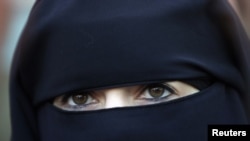The Dushanbe resident, who declined to provide her full name, says she has studied Islam "for some time" and eventually came to the conclusion that wearing the niqab was befitting of her religious beliefs.
"People stare at me in streets," she says. "Some of them call me 'ninja.' But I don't care. It makes my faith even stronger."
In the past year, the number of Tajik women wearing the niqab has grown considerably -- with the trend most evident among women in their late teens or early 20s.
The niqab's rising popularity comes despite a partial ban imposed in 2007 on the comparatively more revealing hijab, branded as an unnecessary foreign import. The wearing of that head scarf, popular among many Tajik Muslim women, is not allowed in state institutions, some public places, and shops.
Surayo Nabieva, a secondary-school teacher in the northern city of Khujand, says the Tajik authorities now face a dilemma. "We thought the hijab was extreme," she says. "Now there is the niqab, which makes the hijab look moderate."
Element Of Arab Culture
Belgium's recently approved ban on Muslim women wearing veils that cover their entire face -- as well as similar legislation being considered in France -- provide examples of the most extreme methods for dealing with the issue. As Tajik authorities ponder the situation, some experts argue that not only do clothing bans fail to keep foreign religious influences at bay, they may end up having the opposite effect.
But as the influence of religion grows in Tajik society, the country can expect to see more women opting for the hijab or niqab as religious diversity rises. Singling out those believers for official scrutiny, observers argue, won't diminish their beliefs or prevent them from looking outside Hanafi tradition.
Fatima says her decision to wear the niqab has led to harassment, with passersby treating her with suspicion or even calling her a "Wahhabi," a term widely used in Tajikistan for religious extremists.
Violates Constitution
Bakhtiyor Nasrulloev, a lawyer who specializes in family law and women's rights, is campaigning to have the ban on head scarves in Tajik schools lifted.
"The ban violates the Tajik Constitution in two ways," says Nasrulloev, who does not see any connection between the ban on head scarves and growing use of the niqab. "First, according to the law, every Tajik citizen has the right to practice their religion of choice. And secondly, every citizen has the right to an education. Denying these young women their education because they wear the hijab is against Tajik law."
Many Muslim women now remove their hijabs just before entering the grounds of universities or schools. Many who have refused have been expelled. Parents of hijab-wearing students, conservative religious groups, and the Islamic Renaissance Party -- the only officially registered Islamic party in Central Asia -- all accuse the Education Ministry of violating citizens' rights. At least one female student has sued the ministry, unsuccessfully.
Education officials appear unbowed. Fourth-year university student Ganjina Sharifova was expelled from Tajik National University on April 26.
"I always comply with the ban when I'm inside the university building and put on my hijab after I leave the building," she says. "But the dean of the university saw me wearing the hijab on my way to the dormitory."
So far, the wearing of the niqab has been seen mostly in the Tajik capital, Dushanbe. But Khujand schoolteacher Nabieva laments that it won't be long before the trend spreads to other regions.
"I don't like the niqab. No one among my family or friends approves of it," Nabieva says. "But I'm afraid it is becoming a fixture of everyday life and no one seems to be able to stop it."













